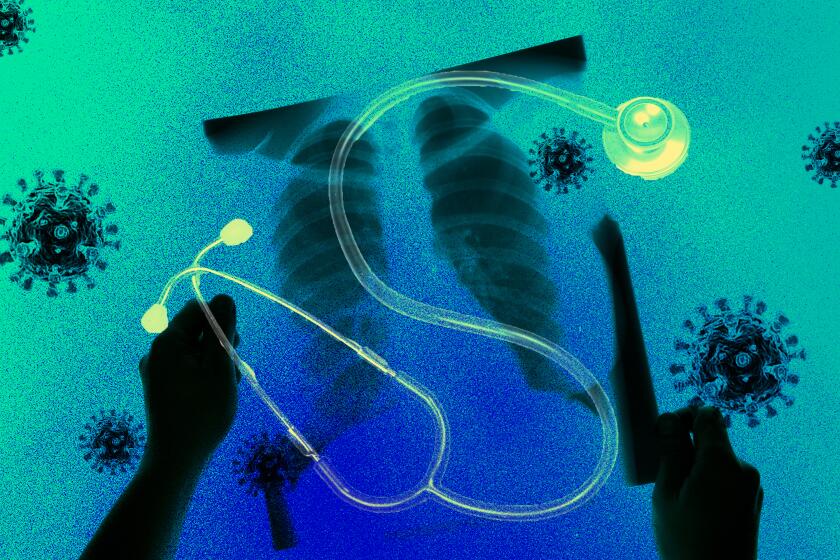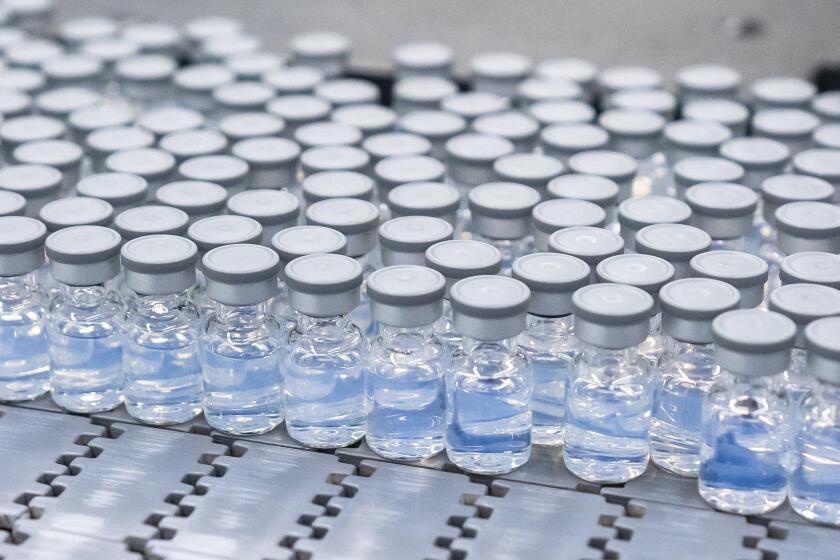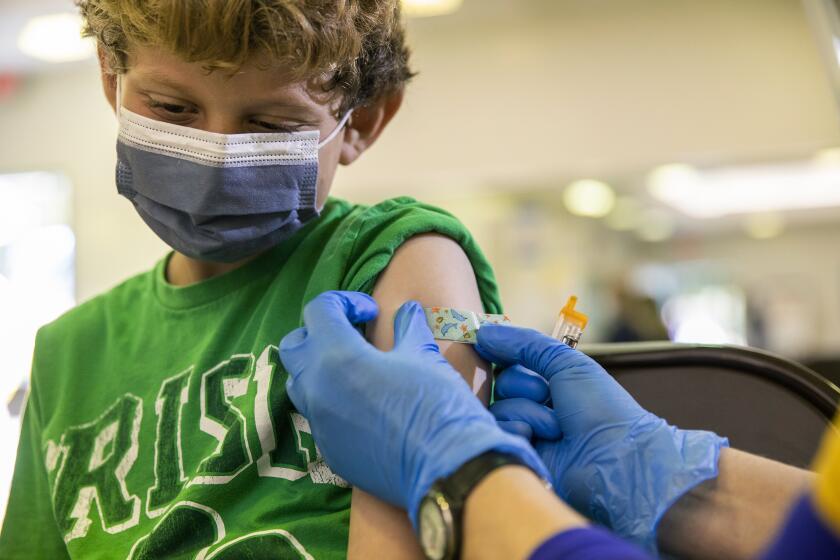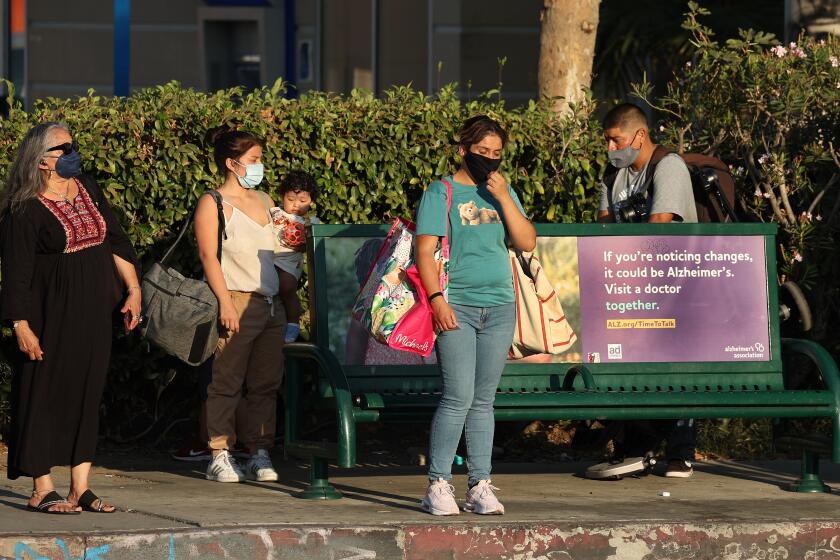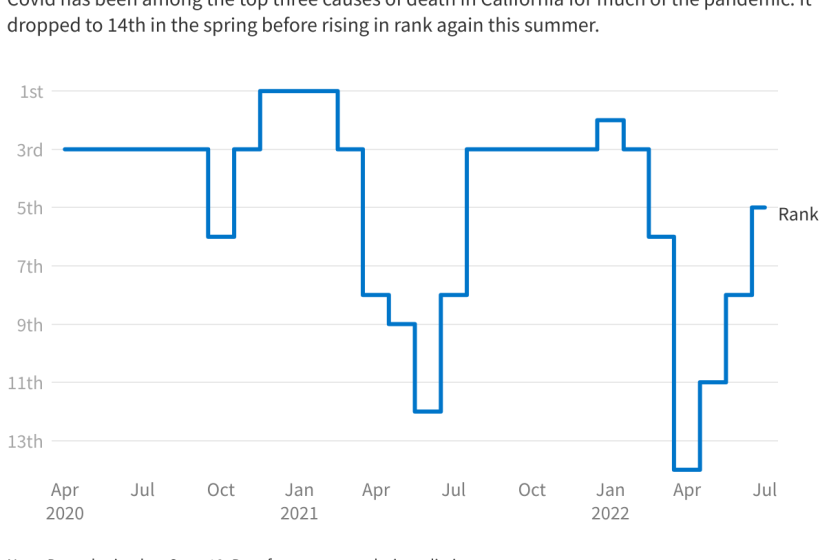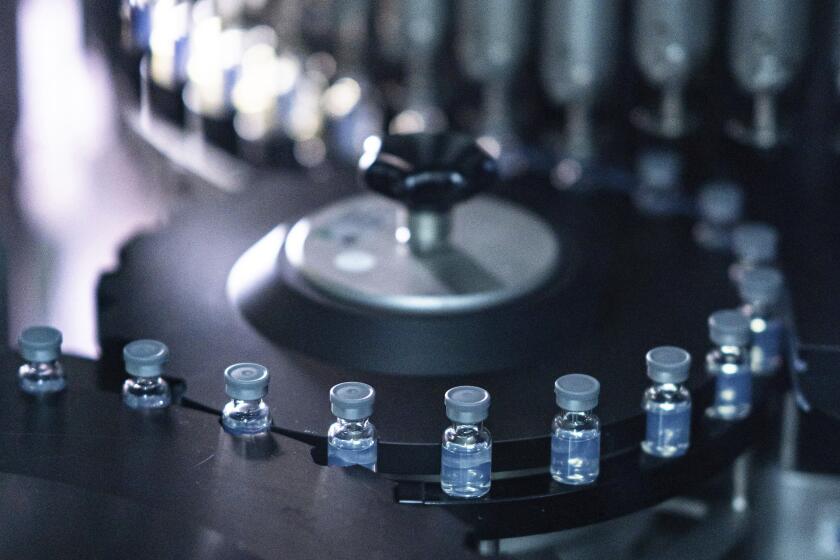California enjoying ‘good COVID weather’ now. But a tough winter could be coming

- Share via
California is entering the fall with coronavirus in retreat.
Cases have fallen significantly from the height of the Omicron wave this spring and summer, and that has allowed government officials to ease both mask rules and recommendations.
But health experts are warning these conditions could change as the weather cools, people head indoors and new variants and subvariants potentially emerge. As the state heads deeper into fall and winter — seasons that previously saw the arrival of the two worst COVID-19 waves to date — officials in Los Angeles County say they can’t rule out the return of mask orders if conditions significantly deteriorate.
Though the situation is much improved from earlier in the year, there are early signs the coronavirus is once again on the upswing in Europe, a development that has previously foreshadowed increases stateside. In England, coronavirus cases over the most recent week are up 13% from the prior week, and hospitalizations are up 17%. Belgium and Denmark have also seen their figures rise, said Dr. Peter Chin-Hong, a UC San Francisco infectious-disease expert.
“Enjoy the good ‘COVID weather,’” Chin-Hong said. But “realize that we have to have flexibility.”
The L.A. Times wants to hear from long haul COVID-19 patients in California and their caregivers about how they’re navigating the challenges of their illness.
Experts are also keeping a wary eye on a number of emerging Omicron subvariants that laboratory studies suggest could still infect people who have been vaccinated or previously infected, and possibly render ineffective some anti-COVID treatments known as monoclonal antibodies.
And locally, observed coronavirus levels are no longer decreasing in L.A. County’s wastewater, indicating that there’s still significant transmission.
Officials regularly note that, thanks to high levels of vaccine coverage and the availability of therapeutics, California could be well positioned to handle a potential coronavirus rebound this year. Aiding that effort is the rollout of updated booster shots specially formulated to target BA.5 — still by far the most common version of the coronavirus in circulation.
But COVID-19 has regularly surprised and scoffed at prognostication. And given California’s previous winter experience, some officials and experts say it would be foolish to rule out a need to mask up in the coming months. Never in modern times has the world dealt with a global pandemic caused by a coronavirus, and it will probably take some time before a predictable pattern emerges.
“When we see things are getting out of hand, we need to go back to the strategies that worked before we had our vaccinations and boosters,” L.A. County Public Health Director Barbara Ferrer said. “If our vaccinations don’t work, because we have a new variant or the new variant evades a lot of protections, you’re going to want to put your mask back on, because that’s going to give you the protection you’re going to need to stay safe.”
A big question with the new COVID-19 vaccine: Can you mix brands? Here is what experts say
Dr. Eric Topol, director of the Scripps Research Translational Institute in La Jolla, said he suspects “we’re going to see more problems with this virus — I mean, if there’s one thing you can bet on, that would be the one.”
Topol said there are at least four subvariants scientists are closely watching that have the potential to cause trouble in the months ahead.
Experts also note, however, that attitudes and recommendations can and should change depending on the pandemic playing field. Chin-Hong, for instance, said it’s reasonable to go out and enjoy many activities sans mask when case rates are lower. But should that change, people should be ready to reach for that extra layer of protection.
But with most mandatory masking rules now far in the rearview mirror, and many people eager to be rid of the 2½-year-old pandemic, it remains to be seen whether residents would be willing to once again don face coverings in certain situations.
L.A., for instance, for months was the only California county to still require masking while aboard public transit and in indoor transportation hubs. But anyone who caught a train or flew out of Los Angeles International Airport before that rule lifted Friday could tell you compliance was spotty, to say the least.
Pfizer asked the FDA to authorize use of its updated COVID-19 booster shot for children ages 5 to 11.
Still, Ferrer said she’s hopeful residents will heed the call “if we’re surrounded by people getting very sick” once again.
“When we’re in a situation where there’s threats to the healthcare system, and we’re being surrounded by people getting very sick … I think people will go ahead and comply,” she said. “These are sensible public health precautions.”
Chin-Hong, for his part, said he thinks people would mask again “when things get bad.”
As of this past June — when the spring and summer Omicron surge was gaining steam — most L.A. County respondents to a survey conducted by USC’s COVID-19 Pandemic Research Center said they still wore a mask at least sometimes when they left home.
In addition, majorities of survey respondents said that fully vaccinated and boosted people should still wear a face mask in crowded indoor settings and agreed doing so reduced the risk of getting a coronavirus infection, Ferrer said.
With cases and hospitalizations declining, health officials said the time has come. In the Bay Area, BART officials voted to end the transit agency’s mandate.
Whether California as a whole, or even a significant number of counties, would ever turn back to mandatory masking remains to be seen.
Last week, the California Department of Public Health largely rescinded its broad recommendation that everyone mask up when in indoor public settings and businesses — guidance that had been in place since mid-February.
Instead, state health officials now recommend universal masking only for counties with a high COVID-19 community level, a category defined by the U.S. Centers for Disease Control that indicates coronavirus transmission has risen to the point that it’s possibly starting to negatively affect hospitals.
Masks remain required in healthcare facilities and long-term and senior care settings under a state health order. The state is also requiring that businesses and venues, including K-12 schools, “must allow any individual to wear a mask if they desire.”
However, the state’s new guidance said nothing about when, or whether, widespread public masking would ever again become mandatory.
But L.A. County, which this summer moved right to the brink of reinstituting a new universal public indoor mask order, has demonstrated a willingness to do so in the event of a serious fall and winter surge.
L.A. County opted to lift its requirement for masking on public transit, including ride-hailing services like Uber and Lyft, and in indoor transportation hubs like airports after the region’s coronavirus case rate fell below the threshold of 100 new cases a week for every 100,000 residents.
But should the rate once again exceed that mark, and stay there for 14 consecutive days, the mask requirement in transit settings would be reinstated, Ferrer said.
The last time L.A. County had a case rate this low was for a 50-day span between March 5 and April 23, before a spate of Omicron subvariants sent case rates climbing during the late spring and summer. Last autumn, the county’s case rate remained under this threshold for a 67-day period, between Sept. 29 and Dec. 4.
However, coronavirus levels in L.A. County wastewater are no longer declining as they once were, and in the Antelope Valley, they may be increasing. Trends of virus in the wastewater for other regions of the county appear to be flat.
“The fact that we’re no longer seeing decreases in wastewater data is a reminder that transmission remains substantial across the county, and sensible precautions will help reduce risk,” Ferrer said.
The number of Californians dying of COVID-19 — and the demographics of those falling victim — has shifted notably from the pandemic’s first two years.
Topol said he thought it was premature for the mask mandate to end for public transit.
“It isn’t like we got down to very low levels of the virus, like we [did in] in June of 2021,” he said. “We’ve still got a lot of cases.”
Should another surge materialize, L.A. County could turn to a universal public indoor mask mandate for residents age 2 and up. Such an order hasn’t been in place since early March.
However, the criteria for pulling that lever again are exacting, and it’s unclear whether the county would ever get to this point, even if transmission once again rises this fall and winter.
Conditions would have to deteriorate to an extent seen only twice before in the pandemic — during the first fall and winter surge that began in late 2020, when morgues were so overwhelmed the National Guard was called in; and the first Omicron surge that struck after Thanksgiving in 2021, which left emergency rooms inundated, ambulances facing delays at hospitals and patients’ scheduled surgeries canceled.
Specifically, L.A. County would need to hit two thresholds to return to a universal mask order.
Assuming there’s an elevated coronavirus case rate, a universal mask mandate would return only if L.A. County saw at least 10 new coronavirus-positive hospital admissions a week for every 100,000 residents and had at least 10% of all staffed inpatient hospital beds occupied by coronavirus-positive patients.
Although a person’s schedule could change depending on health, occupation or travel plans, officials generally recommend the dose before holiday season.
According to the most recent data available, the county is reporting 6.5 new coronavirus-positive hospital admissions per week for every 100,000 residents, and only 3.6% of hospital beds are occupied by such patients.
During the peak of this summer’s wave, L.A. County topped out at 7.2% of hospital beds being taken up by coronavirus-positive patients, though it did temporarily exceed the other hospitalization metric.
There are reasons for optimism heading into the colder months. For starters, no new convincingly worrisome subvariants have emerged in L.A. County to a significant degree, and the updated COVID-19 booster matches the dominant circulating strain. Therapeutics to treat COVID-19 are also widely available.
Children ages 5 to 11 are expected to have access to the updated booster as soon as mid-October, Ferrer said. The updated booster has been available since early September for those age 12 and up.
The latest maps and charts on the spread of COVID-19 in Los Angeles County, including cases, deaths, closures and restrictions.
But Dr. Anthony Fauci, President Biden’s chief medical advisor on the pandemic, said at a talk hosted by the Center for Strategic and International Studies that he expects “it is likely that we will see another variant emerge.” Health officials have long warned that continued transmission could potentially spawn another problematic variant — one that might be more transmissible or better evade the protection afforded by vaccines or previous infection.
L.A. County is monitoring a number of newer, lesser-known Omicron subvariants, but they aren’t circulating in great numbers.
One new variant being tracked is called BF.7. It’s actually a sublineage of BA.5 and thus also known by a more complicated name: BA.5.2.1.7. Officials collected one BF.7 specimen in L.A. County in early August, but no additional cases have been found.
Fauci expressed concerns about another subvariant, BA.2.75.2, and referred to it as “on the horizon, one that looks suspicious.”
More to Read
Sign up for Essential California
The most important California stories and recommendations in your inbox every morning.
You may occasionally receive promotional content from the Los Angeles Times.
